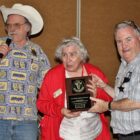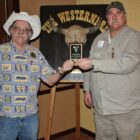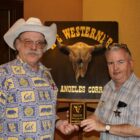Roundup: February 8 2023
WLAC Los Angeles Corral 02.08.23 RoundUp Flyer
Roundup Synopsis
Taken From Branding Iron 309 Winter 2023.
Firearms history through the lens of multiple generations of shooting Dillons. That was our treat in February, as the L.A. Corral’s own Dr. Brian Dillon regaled attendees with a swift, yet detailed, overview of the “shootin’ irons” of Western American history. From the smooth-bore matchlocks of Spanish first contact, to the modern, rifled auto-loaders of the 20th century, the guns that won the West ranged far beyond just the famed 1873 Winchester. We were pleasantly reminded of this fact by the variety of arms, and the folks who wielded them, presented by our eminently qualified former sheriff, and firearms instructor, Brian Dillon.
The aforementioned matchlocks may have been the first firearms present on the continent, but as Spain decided to leave, and stay gone, for a few centuries after their initial introduction in the North, these early irons had no impact on the history of the American West. Rather it was the muskets and rifles of the late 18th and early 19th centuries that first ventured into the West. Lewis and Clark’s expedition made use of later flintlock technology on their epic foray into the new American frontier; the first significant use of firearms west of the Mississippi.
Intrepid trappers, late of the old frontiers in what we now call the Southeast, were among the first to put long irons to use in the further reaches of the West. American adventurers in these early days preferred Pennsylvania rifles, while Canadians pushing west were more known for their use of smooth-bore muskets. The newly-invented percussion cap was too expensive and scarce to be of much utility in the unsettled country, and flintlocks remained in significant use by self-reliant types well into the middle of the 19th century.
The Gold Rush created a huge demand for iron in California, particularly of the defensive variety (after all, nobody will protect your claim but you). Use of the percussion cap quickly made revolvers the standard sidearm of every hunter, trapper, and miner in the rough new country. Perhaps the most iconic arm of the Gold Rush was the 1851 Colt Navy revolver. Six shots ready at the hip were invaluable in this lawless land.
The next major development in firearms was the metallic cartridge. Waterproof and durable, it made reloading a snap, and allowed for reliable mechanisms beyond the revolving cylinder to be used in chambering rounds. One such mechanism was the unforgettable lever action. Patented in 1854 by the Volcanic Repeating Arms Co., it evolved into the action used in the Winchester Model 1873, fabled as “The Gun that Won the West.”
Smokeless powder followed as the next significant leap in the technology of shooting irons, and its introduction heralded the end of the Old West. The Krag-Jorgensen was the first gun adopted by the U.S. military to utilize smokeless powder. There was no turning back from here, and on came the 1903 Springfield of WWI fame, followed by the Colt M1911. A thoroughly modern selfloading pistol, the 1911 represented the end of Old West arms, as by the time of its adoption, the West had largely been won.
The history of the American West can be described fairly thoroughly by telling the history of its weapons. Likewise, the history of American firearms can be largely understood through examination of our country’s westward expansion. And to have those descriptions provided by a compatriot whose ancestors were present on both avenues of that historical journey is a privilege we Westerners should relish. Many thanks to Brian for this presentation.
— Alan Griffin







